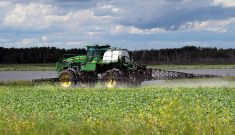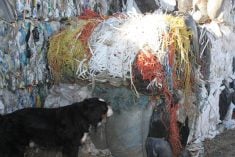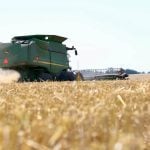MANITOBA
SOUTHWEST
Seeding after June 20
A few days of warm weather may have allowed a few producers in the region to seed a crop after the June 20 insurance deadline. However, less than 30 percent of cropland has been seeded this year south of the Trans-Canada Highway.
Producers are spraying cereal crops for weeds where wet conditions permit.
Canola ranges from emergent to three and four leaf stage. Producers have reported significant flea beetle pressure on canola.
Read Also

Canadian farmers need level playing field for regulations – says Minister MacDonald
Federal agriculture minister Heath MacDonald is urging the Canadian Food Inspection Agency and the Pest Management Regulatory Agency to speed up their decision making.
Hay land remains extremely wet and harvesting will be difficult.
CENTRAL
Weeds a concern
Acreage for many crops, including corn, soybeans, edible bean, flax, peas and sunflowers, will be lower than intended because of soggy seeding conditions this spring.
Producers continue to spray for weeds as dandelions, thistles and quackgrass thrive in wet conditions. Weed pressure is expected to cause problems throughout the growing season because of late and uneven crop emergence.
Significant to high flea beetle pressure on canola has been reported around Portage la Prairie.
NORTHWEST
Some areas faring well
Soil moisture and field conditions range from extremely wet around Ste. Rose du Lac to nearly ideal by Roblin and Swan River. Consequently, 50 percent of cropland is seeded east of Dauphin but nearly 100 percent is seeded west of Grandview.
Most of the canola around Swan River is past the cotyledon stage, and canola fields are even more advanced by Roblin.
Pasture and hay land in the Westlake region is wet as water levels in Lake Winnipegosis, Lake Dauphin and Lake Manitoba remain extremely high.
EASTERN
Spraying for fusarium
In general, fields are not as wet as other parts of the province and crops are more advanced. Early seeded canola has begun to bolt and other canola fields are in the two to six leaf stage.
Soybeans are nearly 100 percent emerged and the earliest seeded crops are in the first trifoliate.
Winter wheat is in good condition and spraying for fusarium head blight has begun.
Haying has begun and one-third of the alfalfa crop has been harvested in some areas. Pastures are good.
INTERLAKE
Pastures poor
Nearly 90 percent of cropland was seeded before the June 20 insurance deadline in the southern Interlake, but only 50 percent in the northern Interlake.
Haying has started and yields are below normal. However, quality is reported as above normal.
Wet pasture conditions are having an impact on animal health in the region. Wet areas are difficult to cross and there have been reports of foot rot and leg injuries.
SASKATCHEWAN
SOUTH
Heavy rain, flooding
The region received more unwelcome moisture June 14-20.
Southeastern areas received 18 to 124 millimetres of precipitation while those in the southwest received three to 100 mm.
Many areas have recorded more than 250 mm of rainfall since April 1. As of June 20, Weyburn had received 383 mm and Big Beaver 415 mm of moisture.
Grain farmers can’t get into their fields to control weeds and cattle farmers can’t access their pastures to process and vaccinate animals. Many producers are still feeding herds in their yards.
Seeding is 44 percent complete in the southeast and 82 percent in the southwest.
Topsoil moisture conditions on cropland are 86 percent surplus in the southeast and 48 percent surplus in the southwest.
All crops are behind normal development, with the exception of fall-seeded crops.
Farmers are hoping for clear skies and good drying weather.
CENTRAL
Weed control delayed
Most farmers welcomed the 18 to 103 mm of precipitation they received, but they now need heat to get the crop, hay land and pastures growing.
Topsoil was drying out in some areas, so the rain was timely for those farmers.
However, there was so much moisture in some areas that weed control operations have halted until the ground dries up. That is a growing concern because many fields in east-central Saskatchewan have heavy weed growth. Leaf diseases are also showing up.
Seeding is 86 percent complete in east-central and 99 percent complete in west-central Saskatchewan.
About half of the cereals and pulse crops in the east-central region are at normal stages of development, while two-thirds of the spring cereals and oilseeds are behind normal.
About half of the spring cereals and oilseeds in the west-central region are at normal stages of development compared to 57 percent of the pulses and 80 percent of the fall cereals.
Some flooding occurred in areas that received significant rainfall.
Cropland topsoil moisture is rated at 59 percent surplus in the east-central and 19 percent surplus in the west-central regions.
NORTH
Area receives timely rain
Rainfall in the northern grain belt was 42 to 190 mm, which is close to the total rainfall received on most farms since April 1.
Topsoil moisture is rated 69 percent surplus in the northeast and 20 percent surplus in the northwest.
Hail damage in the Porcupine Plain, Nipawin, Bruno, Meota and Glaslyn areas is expected to be significant.
Between 59 and 83 percent of crops are at normal stages of development in the northeast. About half of the fall cereals and oilseeds and 60 to 63 percent of pulse crops and spring cereals in the northwest are at normal development.
Some acres are expected to be lost because of flooding, but rain was timely for most growers. Crops that had patchy germination are now filling in and are in good condition.
Some of the canola crops in the northwest had to be reseeded due to frost damage.
Weed control has been delayed because of excess moisture.
Like everywhere else in the province, farmers in the north are hoping for hot weather so crops can catch up.
ALBERTA
SOUTH
Stripe rust a problem
Cool, damp conditions continue to hamper field operations.
Seeding is about 93 percent complete, but most unseeded acres will likely stay as summerfallow.
Spraying for weed control is 25 percent complete.
Most seeded crops are generally in good condition, although development is delayed because of the cool temperatures. Some crops are yellowing in the field and stripe rust has become a serious condition in some fields.
Overall moisture is rated as good to excessive. Pasture and tame hay conditions are in good condition with grass growing well.
CENTRAL
Pests a problem
Seeding is nearing completion in the region, but unseeded fields will likely remain unseeded because of excess moisture.
Crops are generally in good condition, although development is one to two weeks behind normal. Spraying for weeds is about 27 percent complete.
Some areas have reported problems with flea beetles, army cutworms, wireworms and gophers.
Overall moisture is rated as excellent. Pasture conditions are improving and farmers are generally happy with the good pasture growth.
NORTHEAST AND NORTHWEST
Moisture improves crops
Needed rain was finally received over much of northern Alberta, although it was not uniform and some areas received less than 10 millimetres. Surface moisture conditions improved a rapidly deteriorating crop.
Seeding in the area is complete. Some canola was reseeded after an earlier frost, but generally crops are in fair to good condition.
Weed spraying is estimated at 40 percent complete.
Pasture and tame hay growth has also been slow because of spotty rain. Recent rain should help.
PEACE
More rain needed
Farmers breathed a sigh of relief with recent rain over most of the region.
Seeding in the area is complete and spraying for weeds is estimated at 71 percent complete. Overall surface moisture is rated as good to excellent, but farmers are still looking for a bit more rain.
Some areas have reported crop damage from frost. Grasshoppers have become a problem in some areas because of the earlier dry weather.
Pasture conditions are rated as fair to poor because of earlier dry weather. Recent rain should help cattle producers who no longer need to worry about poor grass growth on pastures.














